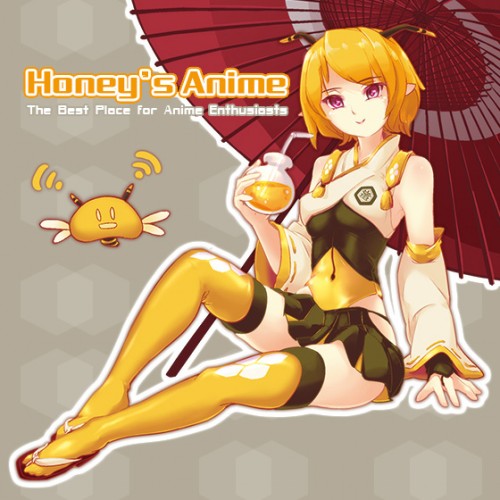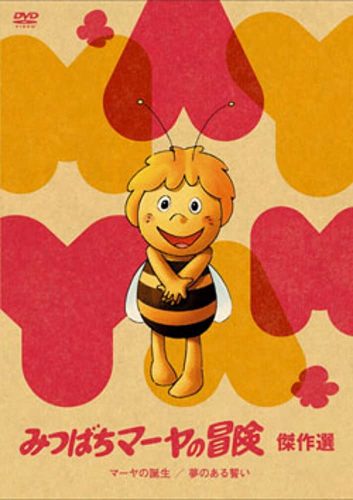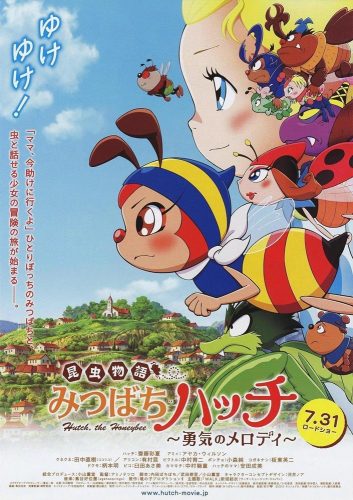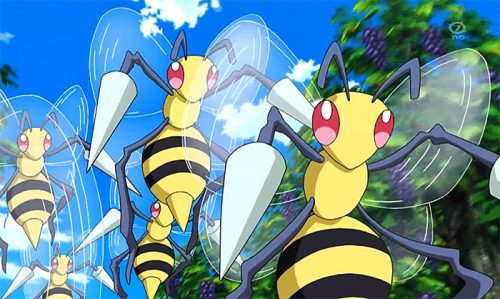
At long last we are finally covering the most appropriate animal for Honey’s Anime, the humble, sometimes bumble, bee. Today we’ll be exploring the history and importance of bees in Japanese culture and showcasing some of our favorite bee characters and moments from anime. For our purposes, we’ll also be including related animals like hornets in these discussions so pedants beware! Let’s get buzzing!
Actual Bees in Japan

Japan harbors a wide variety of native bees, wasps, hornets, and other bee-like insects, quite a few of which have yet to be formally scientifically categorized. Many of these are also found in nearby countries but often have subspecies unique to Japan. The most famous and important of these insects are probably the Japanese honey bee (apis cerana japonica) and the Asian giant hornet (vespa mandarinia, previously thought to be subspecies V. m. japonica) which have developed unique interactions from evolving alongside each other.
Asian giant hornets are notable for being the largest in the world, called osuzumebachi or “giant sparrow bee” in Japanese because of their size. In certain parts of the country, particularly the Chubu region, both adults and larvae are sometimes eaten by humans and were historically important as a source of protein. They are hunted by luring a hornet with raw fish, capturing it, and tying a small piece of paper and string to its body as a guide to follow the hornet back to its nest which is then excavated using smoke to disorient and pacify the hornets.
A Brief History of Japanese Beekeeping
Like in Europe and North America, honey bees have long been the most economically important species to humans. The native Japanese honey bees, a subspecies of the Asian honey bee (apis cerana), have been kept for honey production since at least the 7th century as recorded in the Nihon Shoki, where the practice was sometimes ascribed magical qualities.
In the Meiji period (19th century), imported European honey bees, which produce much more honey, were introduced along with American apiculture techniques which revolutionized the industry in Japan, although traditional techniques still remain in use.
Even though Japanese honey bees produce less honey, they are also much less vulnerable to predators like Asian giant hornets, which viciously attack and devour other bees, thanks to an amazing defensive technique where the bees form a ball around the invading hornets and vibrate their flight muscles frantically to generate CO2 and heat that raise the temperature of the ball to 46 °C (115 °F), suffocating and burning the hornets alive before they can call for reinforcements as the bees can tolerate slightly higher temperatures than the hornets. Perhaps surprisingly, Japanese honey bees are less aggressive than other varieties, very rarely stinging even when directly touched. They are also more resistant to parasites and diseases which has renewed interest in them recently.
Bees in Modern Japanese Culture and Anime

In terms of beekeeping and honey demand nowadays, Japan largely imports honey and relies on European honey bees. Domestic production has remained steady since 2005 but some new efforts like the Ginza Honey Bee Project, which involves rooftop hives on multi-story buildings in Tokyo, have renewed interest and inspired many other urban bee projects throughout Japan and elsewhere.
But what about anime!? Alongside our own Honey-chan and Bee-kun, bees and bee characters have been fairly well represented in anime, although not as much as some other animals. Besides some fun moments like Nakata Sae’s hilarious bee outfit and performance in Amagami SS, the most notable actual bee characters are likely Maya from Mitsubachi Maya no Bouken (Maya the Bee), which is based on the German children’s book of the same name, and Hutch from Konchuu Monogatari Minashigo Hutch (The Adventures of Hutch the Honeybee). Both of these are older children’s series, although Hutch has surprisingly made a bit of a comeback fairly recently with a 2010 feature film and a 2014 short series where he meets members of popular idol groups AKB48, SKE48, NMB48, and HKT48. Charmy the Bee was also part of the Sonic X anime, largely reprising his role as a member of Chaotix with his usual hyperactive and naive personality.

Other bees are more symbolically linked like the Letter Bees of Tegami Bachi, elite mail deliverers who have to fight giant insect monsters called Gaichuu using weapons that shoot part of their hearts every time they use their weapons like bees dying after using their singers. Another rather interesting example is the bizarre Flame-Wreath Bee that the Karen Bee arc of Nisemonogatari centers around which afflicts Araragi Karen—who herself is symbolized by and dresses like a bee—and features prominently in her OP. Some characters also have bee-based abilities like Hunter x Hunter fan-favorite Ponzu who can summon special bees from her bee-hive-shaped hat. More recently, Dokonjofinger’s bassist Hachin from this year’s Show By Rock!! Mashumairesh!! proves that bee characters are here to stay, and to rock!
Final Thoughts

There are likely countless instances of bees in anime and manga but we’ll close with mentioning the brilliant fencing duel Sakamoto has with a bee in the first episode of Sakamoto Desu ga? (Haven't You Heard? I'm Sakamoto) using a compass against its stinger. Bees and hornets have had a long and continuing legacy in Japan that may prove even more important in coming years thanks to the unique advantages of Japanese honey bees. In any case, we hope you enjoyed this foray into the sweet world of bees! Bee sure to stick around Honey’s for more of all things awesome, anime and otherwise! Until then, stay busy and buzzy! See ya~

